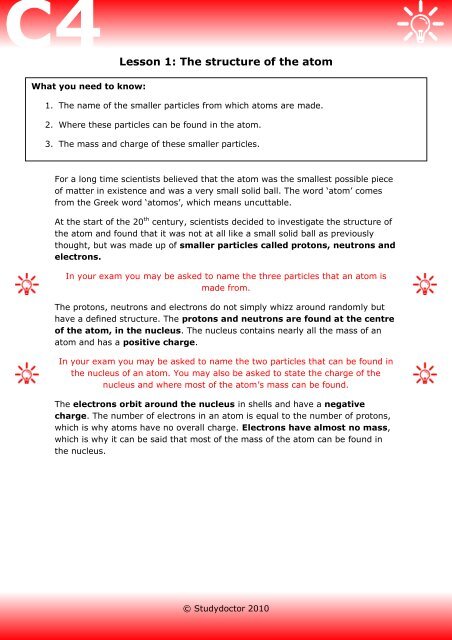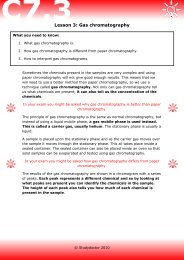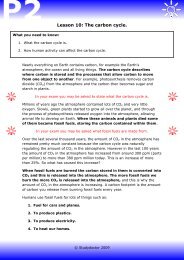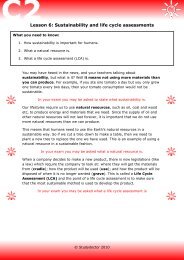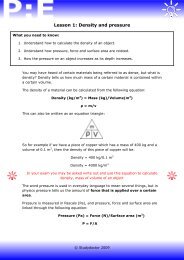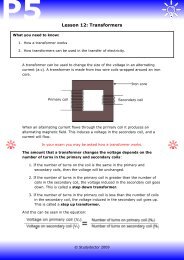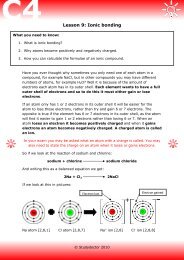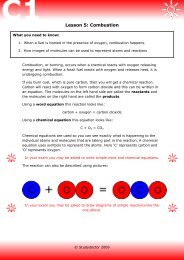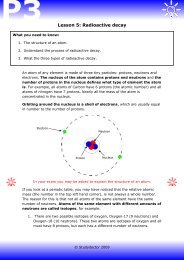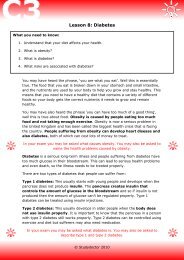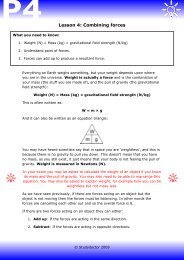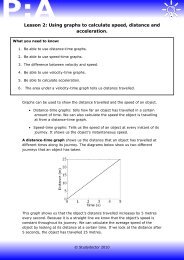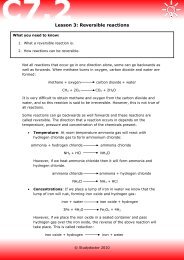Open lesson 1: The structure of the atom
Open lesson 1: The structure of the atom
Open lesson 1: The structure of the atom
You also want an ePaper? Increase the reach of your titles
YUMPU automatically turns print PDFs into web optimized ePapers that Google loves.
Lesson 1: <strong>The</strong> <strong>structure</strong> <strong>of</strong> <strong>the</strong> <strong>atom</strong><br />
What you need to know:<br />
1. <strong>The</strong> name <strong>of</strong> <strong>the</strong> smaller particles from which <strong>atom</strong>s are made.<br />
2. Where <strong>the</strong>se particles can be found in <strong>the</strong> <strong>atom</strong>.<br />
3. <strong>The</strong> mass and charge <strong>of</strong> <strong>the</strong>se smaller particles.<br />
For a long time scientists believed that <strong>the</strong> <strong>atom</strong> was <strong>the</strong> smallest possible piece<br />
<strong>of</strong> matter in existence and was a very small solid ball. <strong>The</strong> word ‘<strong>atom</strong>’ comes<br />
from <strong>the</strong> Greek word ‘<strong>atom</strong>os’, which means uncuttable.<br />
At <strong>the</strong> start <strong>of</strong> <strong>the</strong> 20 th century, scientists decided to investigate <strong>the</strong> <strong>structure</strong> <strong>of</strong><br />
<strong>the</strong> <strong>atom</strong> and found that it was not at all like a small solid ball as previously<br />
thought, but was made up <strong>of</strong> smaller particles called protons, neutrons and<br />
electrons.<br />
In your exam you may be asked to name <strong>the</strong> three particles that an <strong>atom</strong> is<br />
made from.<br />
<strong>The</strong> protons, neutrons and electrons do not simply whizz around randomly but<br />
have a defined <strong>structure</strong>. <strong>The</strong> protons and neutrons are found at <strong>the</strong> centre<br />
<strong>of</strong> <strong>the</strong> <strong>atom</strong>, in <strong>the</strong> nucleus. <strong>The</strong> nucleus contains nearly all <strong>the</strong> mass <strong>of</strong> an<br />
<strong>atom</strong> and has a positive charge.<br />
In your exam you may be asked to name <strong>the</strong> two particles that can be found in<br />
<strong>the</strong> nucleus <strong>of</strong> an <strong>atom</strong>. You may also be asked to state <strong>the</strong> charge <strong>of</strong> <strong>the</strong><br />
nucleus and where most <strong>of</strong> <strong>the</strong> <strong>atom</strong>’s mass can be found.<br />
<strong>The</strong> electrons orbit around <strong>the</strong> nucleus in shells and have a negative<br />
charge. <strong>The</strong> number <strong>of</strong> electrons in an <strong>atom</strong> is equal to <strong>the</strong> number <strong>of</strong> protons,<br />
which is why <strong>atom</strong>s have no overall charge. Electrons have almost no mass,<br />
which is why it can be said that most <strong>of</strong> <strong>the</strong> mass <strong>of</strong> <strong>the</strong> <strong>atom</strong> can be found in<br />
<strong>the</strong> nucleus.<br />
© Studydoctor 2010
Electron<br />
Neutron<br />
Proton<br />
Nucleus<br />
In your exam you may be asked where electrons can be found in an <strong>atom</strong>.<br />
After studying protons, neutrons and electrons, scientists were able to calculate<br />
<strong>the</strong> mass and charge <strong>of</strong> each <strong>of</strong> <strong>the</strong>se <strong>atom</strong>ic particles. <strong>The</strong> table below shows<br />
<strong>the</strong> relative mass and charge <strong>of</strong> a proton, neutron and electron.<br />
Particle Mass Charge<br />
Proton 1 +1<br />
Neutrons 1 0<br />
Electrons 0 -1<br />
In your exam you may be asked to complete this table, stating <strong>the</strong> mass and<br />
charge <strong>of</strong> a proton, neutron and electron.<br />
Scientists are still trying to investigate <strong>the</strong> <strong>structure</strong> <strong>of</strong> <strong>the</strong> <strong>atom</strong>, and this is why<br />
<strong>the</strong> Large Hadron Collider (LHC) was built in Geneva. By smashing protons<br />
toge<strong>the</strong>r <strong>the</strong>y hope to break <strong>the</strong> protons apart and be able to find out what <strong>the</strong><br />
protons, neutrons and electrons are made from.<br />
In your exam you might be asked to explain how scientists are trying to discover<br />
what protons, neutrons and electrons are made from.<br />
© Studydoctor 2010
Recap:<br />
1. An <strong>atom</strong> is not <strong>the</strong> smallest types <strong>of</strong> matter.<br />
2. Atoms are made from smaller particles called protons, neutrons and electrons.<br />
3. Protons and neutrons are found at <strong>the</strong> centre <strong>of</strong> <strong>the</strong> <strong>atom</strong>, called <strong>the</strong> nucleus.<br />
4. Electrons orbit around <strong>the</strong> nucleus in shells.<br />
5. Protons have a mass <strong>of</strong> 1 and a charge <strong>of</strong> 1, neutrons have a mass <strong>of</strong> 1 but no<br />
charge and electrons have a mass <strong>of</strong> 0 and a charge <strong>of</strong> -1.<br />
Fur<strong>the</strong>r information:<br />
1. Here is a quick explanation <strong>of</strong> <strong>the</strong> Large Hadron Collider:<br />
http://www.youtube.com/watch?v=TMPdmDE72AU<br />
© Studydoctor 2010


